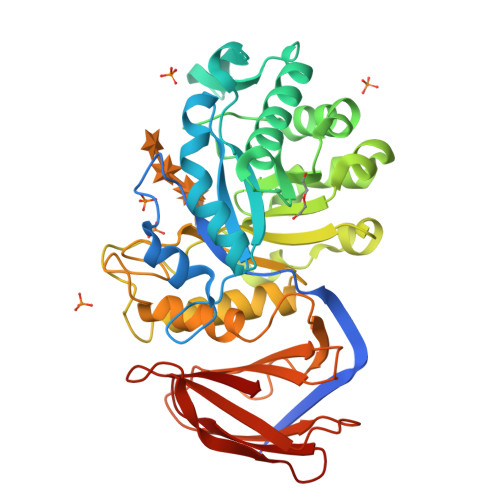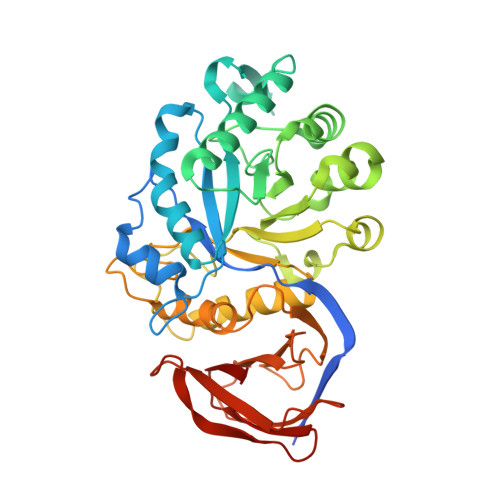Conservation in the Mechanism of Glucuronoxylan Hydrolysis Revealed by the Structure of Glucuronoxylan Xylano-Hydrolase (Ctxyn30A) from Clostridium Thermocellum
Freire, F., Verma, A.K., Bule, P., Alves, V.D., Fontes, C.M.G.A., Goyal, A., Najmudin, S.(2016) Acta Crystallogr D Biol Crystallogr 72: 1162
- PubMed: 27841749
- DOI: https://doi.org/10.1107/S2059798316014376
- Primary Citation of Related Structures:
4CKQ, 4UQ9, 4UQA, 4UQB, 4UQC, 4UQD, 4UQE, 5A6L, 5A6M - PubMed Abstract:
Glucuronoxylan endo-β-1,4-xylanases cleave the xylan chain specifically at sites containing 4-O-methylglucuronic acid substitutions. These enzymes have recently received considerable attention owing to their importance in the cooperative hydrolysis of heteropolysaccharides. However, little is known about the hydrolysis of glucuronoxylans in extreme environments. Here, the structure of a thermostable family 30 glucuronoxylan endo-β-1,4-xylanase (CtXyn30A) from Clostridium thermocellum is reported. CtXyn30A is part of the cellulosome, a highly elaborate multi-enzyme complex secreted by the bacterium to efficiently deconstruct plant cell-wall carbohydrates. CtXyn30A preferably hydrolyses glucuronoxylans and displays maximum activity at pH 6.0 and 70°C. The structure of CtXyn30A displays a (β/α) 8 TIM-barrel core with a side-associated β-sheet domain. Structural analysis of the CtXyn30A mutant E225A, solved in the presence of xylotetraose, revealed xylotetraose-cleavage oligosaccharides partially occupying subsites -3 to +2. The sugar ring at the +1 subsite is held in place by hydrophobic stacking interactions between Tyr139 and Tyr200 and hydrogen bonds to the OH group of Tyr227. Although family 30 glycoside hydrolases are retaining enzymes, the xylopyranosyl ring at the -1 subsite of CtXyn30A-E225A appears in the α-anomeric configuration. A set of residues were found to be strictly conserved in glucuronoxylan endo-β-1,4-xylanases and constitute the molecular determinants of the restricted specificity displayed by these enzymes. CtXyn30A is the first thermostable glucuronoxylan endo-β-1,4-xylanase described to date. This work reveals that substrate recognition by both thermophilic and mesophilic glucuronoxylan endo-β-1,4-xylanases is modulated by a conserved set of residues.
Organizational Affiliation:
CIISA-Faculdade de Medicina Veterinária, Universidade de Lisboa, Avenida da Universidade Técnica, 1300-477 Lisboa, Portugal.





















